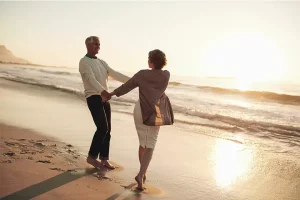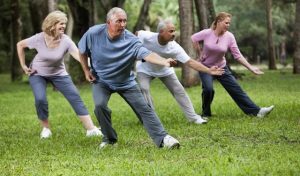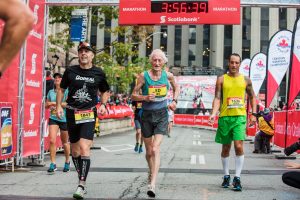6
Section One: The Fundamentals
A) Keywords
Exercise 1:
Provide a brief definition of one of the padlet keywords for this week.
| Third age is the period of life following retirement, often beginning around the mid 60s. This is when people are no longer working full time but remain active, independent and emersed in a number of pursuits. This stage is typically associated with travel, volunteering, personal growth, lifelong learning and other various fulfilling activities that contribute to well-being. Unlike earlier stages in life, where the focus is on family responsibilities and career, the Third Age is viewed as a time of leisure, self-discovery and more social involvement before the possible cognitive and physical challenges of later old age.
|
B) The Social Significance of Aging in Sport
Exercise 2: Notebook Prompt
How is old age popularly represented today? Find an image online that you think exemplifies one defining attitude towards old age and paste in your notebook below with a brief explanation of what this image means to you.

Nowadays, a picture of an older couple strolling hand in hand along a beach at sunset is frequently used to symbolize old age. Advertisements for healthcare, wellness, and retirement planning items aimed at senior citizens usually employ this kind of image. It presents a distinctive mindset that aging is a period of calm, reflection, and unity, frequently depicting elderly people as contentedly and comfortably living out their later years. This picture, in my opinion, portrays a romanticized view of aging—one that places more emphasis on contentment, stability, and love than on the challenges that frequently accompany aging. Although it is an optimistic and aspirational picture, it could also ignore the difficulties that many older people have, like deteriorating health, loneliness, or unstable finances. Because it gives the impression that everyone will age in the same carefree and contented manner, this selective portrayal might lead to inflated expectations about aging. But in actuality, growing older is a complicated process that differs widely based on individual circumstances, health, and social support.
|
Exercise 3: Notebook Prompt
What does the article (referencing another study by Dionigi) mean by its statement that sport can help aging people to simultaneously “accept and resist the ageing process” (572)? Respond by audio or text and find paste two images sourced online into your notebook showing how sport might help aging people to both accept and resist the aging process.
|
The statement that sports aids aging people to simultaneously ‘accept and resist the aging process’ means that taking part in physical activity allows older adults to recognize the natural changes that accompany aging while also challenging some of its limitations. By engaging in sport, elderly individuals accept aging by adapting their bodies to new physical realities, acknowledging changes in endurance, flexibility and strength. At the same time, they resist aging by maintaining physical fitness, staying active and fighting societal stereotypes that associate old age with inactivity or fragility. Sports supplies a way to engage with aging on one’s own terms, strengthening empowerment and self-acceptance. For instance, this image of a senior athlete running a marathon illustrates resistance to aging, as these particular individuals demonstrate endurance and strength beyond normal expectations. On the other hand, this image of older people taking part in low impact activities like tai chi or yoga can symbolize acceptance of aging by highlighting how they are able to adapt to their changing physical abilities while still putting their health first. |
Exercise 4: Notebook Prompt
Who are the groups less likely to have extensive opportunities to take part in sports, according to Pike? How does privilege factor into aging and sport? (200 words max)
| In her paper “Assessing the Sociology of Sport: On Age and Ability,” Elizabeth Pike lists a number of demographics that are less likely to have many chances to engage in sports, including women, older persons, and those from poorer socioeconomic backgrounds. These groups frequently encounter systemic obstacles such restricted facility access, economic limitations, and cultural norms that discourage involvement.
Because people who have greater financial, social, or cultural resources are more likely to continue playing sports throughout their lives, privilege has a big impact on aging and sports. People from greater socioeconomic origins, for instance, might have access to private gyms, sports clubs, or coaching, which would allow them to continue exercising into old life. On the other hand, people with less money can encounter challenges such restricted access to suitable sports programs, medical care, or safe environments for physical exercise. Furthermore, privilege affects how older people are perceived in the context of athletics. For instance, older persons who are well-off or in good health might still be viewed as competent athletes, but others who are less fortunate might be marginalized or have less chances to challenge how society views aging and ability.
|
Exercise 5: Padlet Discussion
Why do you think age discrimination is “reported more than any form of prejudice” with older people presented as a threat to social values and interests? Feel welcome to use video in your responses. Paste your comments (or transcript of your video) below!
| Since older individuals are usually seen as a danger to collaborative ideals and interests, particularly in countries that place a high emphasis on youth, productivity, and creativity, age discrimination is generally recorded at higher rates than other types of prejudice. While senior age is sometimes viewed as a time of decline and dependency, youth is frequently associated with vitality, creativity, and economic contribution in many cultures. Older persons may be marginalized in the media, in the workplace, and even in social situations as a result of this systemic bias.
The idea that older people are a “threat” to societal advancement may be fueled by stereotypes that portray them as burdens on society who are incapable of making significant contributions. For example, negative representations of older people in the media and political discourse have resulted from worries about healthcare, pensions, and the influence of the aging population on economic systems. These stories have the potential to reinforce ageism and make it easier to ignore the contributions that older people still make to their communities, families, and even the workplace—especially in positions where knowledge and expertise are highly valued. Furthermore, society may find it challenging to accept aging as a normal and worthwhile process due to the ongoing cultural emphasis on youth, which instead views it as something to be avoided or feared. This style of thinking reinforces stereotypes and the perception that aging is something that is intrinsically bad or a danger to social ideals by supporting the concept that older persons must “resist” aging in order to maintain their value. These portrayals promote a cycle of discrimination and exclusion that ignores older people’s daily reality.
|
B) Older Women and Sport
Exercise 6: Notebook Prompt
What differences do you see in these ads? Which one is more inclusive? How is age represented or not represented in each? Answer these questions in your notebook.
| The two ads show distinct portrayals of inclusivity, age and representation in sport and physical activity.
Nike’s ad put emphasis on resilience, unity, and overcoming obstacles through sport. The ad shows a diverse range of athletes from different backgrounds, genders and abilities, utilizing a split screen to highlight the connections between them. While the ad is very inclusive in terms of gender, race and ability, age is not actively represented. Majority of the athletes shown were young, reinforcing the typical association of sport with youth and high performance instead of lifelong participation. Older individuals were largely absent, suggesting that sport is viewed as primarily for the young. The second ad, challenges stereotypes about aging by featuring older women exercising. This ad directly rejects the notion that aging means becoming inactive or slowing down. The ad shows older people, women in particular, not as fragile or passive but as competitive, strong and full of energy. In this way, it is more inclusive of age than the Nike ad, offering representation that disrupts common stereotypes of aging and ability. Overall, the Nike ad does not eliminate age-related misconceptions, despite its strong inclusivity of gender, ethnicity, and ability. On the other hand, the second ad more explicitly embraces aging, demonstrating that competitive sports and physical exercise are not just for young people. As a result, it represents age in sports in a more progressive manner. |
Exercise 7: Notebook Prompt
In her article, “Assessing the sociology of sport: On age and ability,” Elizabeth Pike references a “trend towards a ‘feminisation of ageing’, with many women living longer than men” (573). Do you agree that aging has been “feminized” in this way? How? Answer these questions in your notebook.
| I do believe that aging has been “feminized” in some respects, particularly in light of women’s higher life expectancy than men’s, as Elizabeth Pike mentions. This tendency is frequently presented in a way that emphasizes the unique biological and societal obstacles that women encounter as they age.
One aspect of this “feminization of aging” is the focus on women’s physical and aesthetic aging. Women are under a lot of pressure in many countries to seem young throughout their lives because aging is frequently associated with a decline in one’s beauty, value, and desirability. As a result, older women are held to different standards than older men. Women are more likely to be judged on their appearance, which can cause feelings of inadequacy or invisibility as they age, whereas men are frequently let to age more gracefully and some even become more respected or attractive as they age (e.g., the “silver fox” stereotype). Furthermore, many women experience the effects of aging for longer than men do due to their longer life expectancy. Because of this, women may be more susceptible to age-related health problems and frequently have to manage caregiving responsibilities for elderly husbands, children, or grandkids. Because the social and cultural narratives around aging are frequently gendered in ways that place additional expectations and challenges on women, these factors contribute to the “feminization” of aging. Therefore, although everyone is impacted by aging, gender can have a big impact on how it is experienced and perceived.
|
Section Three: Module Mini Assignment
| The growing popularity of pickleball among older adults has ignited discussions, especially in Peterborough, Ontario, where community members have disputed the building of new courts in public parks. Although worries over noise, expense, and land use are at the heart of the discussion, the depiction of older pickleball players in media reports prompts questions into ageism and neoliberal views on aging.
The Global News article portrays older pickleball supporters as a vocal and entitled group that disturbs community harmony, with one resident describing them as “a small group of people who are very loud” (Global News). At the same time, Peterborough Currents offers a critique of the city’s expenses on pickleball, subtly characterizing older players as a privileged group that is depleting public resources. These portrayals correspond to Elizabeth Pike’s assertion that there are often stereotypes applied to aging athletes—viewing them as either “inspirational” for remaining active or as burdensome for requiring accommodations (Pike, 2023). The Narwhal article, although sympathetic to the cause of park preservation, nonetheless presents the conflict as one between generations, with older pickleball enthusiasts on one side and younger environmentalists on the other. Neoliberal ideals that prioritize individual responsibility above collective welfare are reflected in the discourse. It is anticipated that older pickleball players will champion their own causes (for instance, raising money for courts) instead of depending on public backing—this aligns with Pike’s criticism of the ways in which aging bodies are conditioned to engage in “productive” leisure (Pike, 2023). Media representation frequently overlooks systemic age-based inequalities in sports infrastructure, framing the discussion instead as a zero-sum competition for resources. Although pickleball is undoubtedly popular among older adults, media portrayals may reinforce ageist stereotypes and neoliberal expectations that older citizens must justify their presence in public spaces. A detailed discussion should address how cities can support aging populations equitably without marginalizing other groups.
References Global News. (2023, October 12). What’s all the racket? Residents oppose pickleball courts at park in Peterborough, Ont. https://globalnews.ca/news/10402091/whats-all-the-racket-residents-oppose-pickleball-courts-at-park-in-peterborough-ont/ Peterborough Currents. (2023, October 18). How else could we spend our pickleball money? https://peterboroughcurrents.ca/analysis/how-else-could-we-spend-our-pickleball-money/
|



